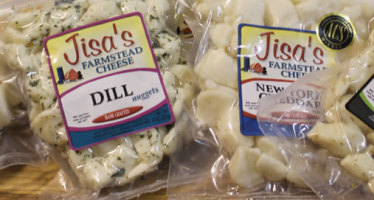Prairie Food Grows from Deep Roots
Review: ‘New Prairie Kitchen: Stories and Seasonal Recipes from Chefs, Farmers, and Artisans of the Great Plains’ by Summer Miller
If your great-great-grandmother appeared in your kitchen, she might tell you to put that protein shake down and eat some real food. She might tell you a lot of other things, but when she talked to you about food, it would resonate. It would have a sense of history, of narrative and a gentle authority that came from understanding food and its origins and from her experience feeding people.
Now, if your GGM stood there, (let’s say you didn’t pass out on the floor from shock) and told you how to prepare and enjoy food with month-old techniques and thousand year-old ones, you’d probably listen, because her advice wouldn’t be a replay of some whole-food paleo-diet anti-gluten mantra that’s been passed along and diluted like the telephone game. If your GGM (or GGF) told you about real food, good food, it would be a similar experience to reading Summer Miller’s new book, “New Prairie Kitchen,” published this year by Midway Press. It offers a stroll through the kitchens and farms of the Midwest.
I read the recipes like someone reading a note from a friend and I drank in the sumptuous photographs that draw one into that Midwestern rural farm setting. But as I wound my way through the seasons and the stories of farms and families, I felt myself tugged forward, reminded of the past, but focused clearly on the present and future of food. These glimpses of meals made me yearn for gardens and markets and family stalls. They made me want to cook something fresh and delicious. Most of all, they made me want to eat some of the truly spectacular food found in this book.
Even if a spring country pork pâté seems beyond you, I think you may change your mind when you read the one shared by chef Bryce Coulton from The French Bulldog in Omaha. He is known for his charcuterie, the French art of preserving and curing meats. Like all of the recipes in this book, it comes from a chef who is doing wonderful things with local foods, This pâté looks magnificent and if you go to the simple worthy step of making his quick, homemade piccalilli to go with it, you’d better have a nice cold glass of Pinot Blanc or Riesling ready, because you are going to want to sit in the sun and be transported to the breezy slopes of Alsace.
But there is something, truly, for every palate in The New Prairie Kitchen. From Maggie Pleskac, of Maggie ’s Vegetarian Café in Lincoln, we get a savory roasted rhubarb and asparagus pasta salad. And Jason Simon from Alba in Des Moines, Iowa gives us a vibrant, caramelized pattypan squash salad with summer peaches.
There is great variety and depth to these recipes. I enjoyed reading them almost as much as I enjoyed the tour of Midwestern chefs and their stories that introduce the segments and the food. The diversity here, in my opinion, makes the recipe collection a valuable one. The vegetarian dishes are just as complex and enjoyable as the savory carnivorous ones; something not typically seen in cookbooks or even collections of recipes. In my experience, most local food collections of recipes, Old World or New World, is usually cursory in its sampling; the main point being to showcase ingredients.
The way this collection is put together breaks through that pattern, and the veggies and fresh cheese are taken way beyond just squirt the lemon, sprinkle the olive oil and slap it on the plate. In other words, these recipes make the food sing.
There are several knock-out gnocchi recipes here, all from accomplished local chefs, who make it plain that gnocchi can elevate a potato dumpling to delicate, yet hearty poetry. If making homemade pasta is not your thing, each chef’s restaurant and profile is laid out here for you, so you can go out for a memorable meal and sample anything you don’t feel like making yourself. Here we have a guidebook to local restaurants that are doing creative, new things with food grown and processed right here on the prairie.
Tricks and tips from chef-owner-cooks abound and come from deep roots of understanding taste profiles, balance and deft handling of ingredients. Paul Kulik, from Omaha’s The Boiler Room, schools us about the right heirloom tomatoes and how to coax them into a lovely consommé. Nick Strawhecker of Dante Ristorante Pizzeria in Omaha shares the best to way to brine and then braise a chicken for a concentration of flavors that far outstrips most people’s vision of chicken soup. Clayton Chapman of Omaha’s The Grey Plume explains why radishes and ramps with signature George Paul Vinegar are really the right thing to pair in a roast of South Dakota grass-fed lamb. Bryce Coulton teaches us how to poach eggs properly in the shell (forget simmering in water with vinegar where you lose more egg and get sad that your egg tastes watery and acidic) and then snug the eggs up onto toasted cornbread, roasted tomatoes and tesa (a cured pork belly that is not your grandmother’s bacon.)
Not really your grandmother’s food, this book, and yet it is. Somehow, it is your grandmother’s and your immigrant or Native American great-grandmother’s and your distant Huguenot relative’s and your Polish family’s food. It nods respectfully to Italy and France, the cradles of treating food as artisan craft, art and culture, and then it gathers up those roots into a basket of goodies being grown, produced and treated with love right here in the Midwest.
This history makes the list of references for sourcing local food in each recipe the truly unique part of this book. You can find where to get grass-fed meats, cured pork, cheeses, garden fresh vegetables of every sort and color, fermented products such as vinegars, milk, eggs, hard wheat flour and locally grown chicken, herbs, oats and honey.
Everything you see in the clear, honest photography of Dana Damewood shows the bounty of what is here in the Midwest and is available to us all. They show us the deep connection with food that has re-seeded and grown large here in “flyover country”. We feel much more a part of a food heritage that goes back centuries and reaches forward into pastures and back yards all over Nebraska, Iowa and South Dakota. The stories draw you in while the photos make you hungry and grateful. I can’t recall any other time that pictures of goats actually made me salivate.
Seasonality, which we hear a lot about these days, is sort of a mystery for many of us.
To really appreciate why growers and chefs champion this concept, you must understand that food comes from somewhere in limited quantities and at limited times. Most of us understand how nice our own garden’s spring peas and summer tomatoes taste in comparison to supermarket produce, but unless we raise livestock or fish and hunt, we don’t actually experience harvesting proteins. Many products are simply available all year; I’m not at all sure that tofu (at least in the U.S.) has a season. But in “Prairie Food”, the mystery unwinds for us. Laid out in these pages are the stories of people in love with their food and the land which makes it.
We read about Iowan farmers like Terra and Matthew Hall of Rhizosphere Farm, Renee and Jim Small of Small’s Fruit Farm and Larry Cleverley of Cleverley Farms, about how they don’t just grow the food, eat it and sell it – they are connected to it. The truly beautiful thing about these modern farmers is that unlike families in the past who had little to no choice of how to make a living, they have chosen to do this. For these family farms, good food is a calling and a passion.
If you’ve watched “slow food” documentaries featuring people who don’t want food and drink to be simply commodities, you might be tempted to think all those people live in California or Maine or Cheshire, England. This book proves the contrary. Many of them are right here; farmers, growers, brewers, bakers and artisans, growing and cooking and crafting food on the prairie lands of the Midwest. To experience food produced in these time-tested and loving ways can be a mind-blower. If you’ve never eaten bison, I suggest you get up right now and fix that error.
You see, a soul-satisfying thing happens when you eat within a culture, a season, a place. Like French cuisine – it’s really important – to French people. We need to find and cultivate our own culinary roots. As Dave Hutchison of Hutchison Organic Ranch in Rose, Nebraska says of keeping a healthy bison herd, “You want to keep the great-great grandmothers and the great-great grandfathers around because they teach the calves how to be buffalo”. He’s one of the people in “Prairie Food” that is managing a whole ecosystem, and sharing it with anyone who cares to eat well and connect to family through food.
And that is exactly what your great grandmother would tell you to do.

Ann Summers
Ann Summers is not a 40-umpthing-year old rock climber who got shut down in Boulder Canyon and drowned her failure in a microbrewery. She is neither a mother of two, a fan of Latin plant names nor a lover of fine Italian Grappa. You’ll not catch her shooting guns for fun or hollering like a redneck. She hates Shakespeare, and doesn’t call a certain fast food chain “The Scottish Restaurant.” She turns her nose up at organic yellow beets, eschews fresh oysters, and loathes chubby guinea pigs with Violent Femmes hairdos. She is also a dreadful liar
Related Articles
20 Questions: Steve Villamonte
MR: Chef, tell us about your family history in culinary arts and how it has influenced your career choices. SV:
Five of our Favorite Appetizers
It seems as though everybody has a list these days. Best of this, best of that – but what really
FSM’s Interview with Cat Cora
Cat Cora will host The Food Bank’s 8th Annual Celebrity Chef Fundraiser on February 26th. I was able to catch
No comments
Write a commentOnly registered users can comment.














